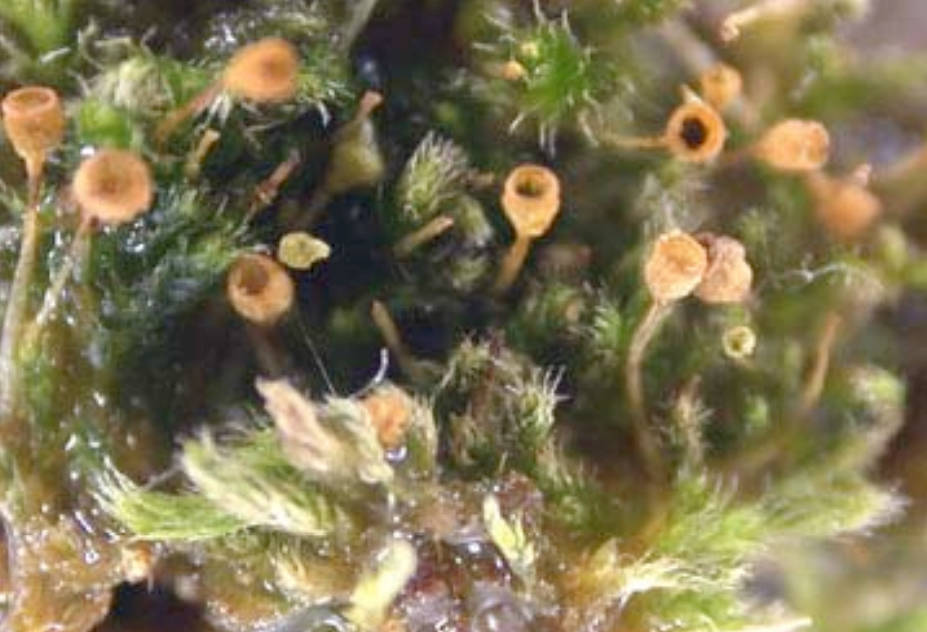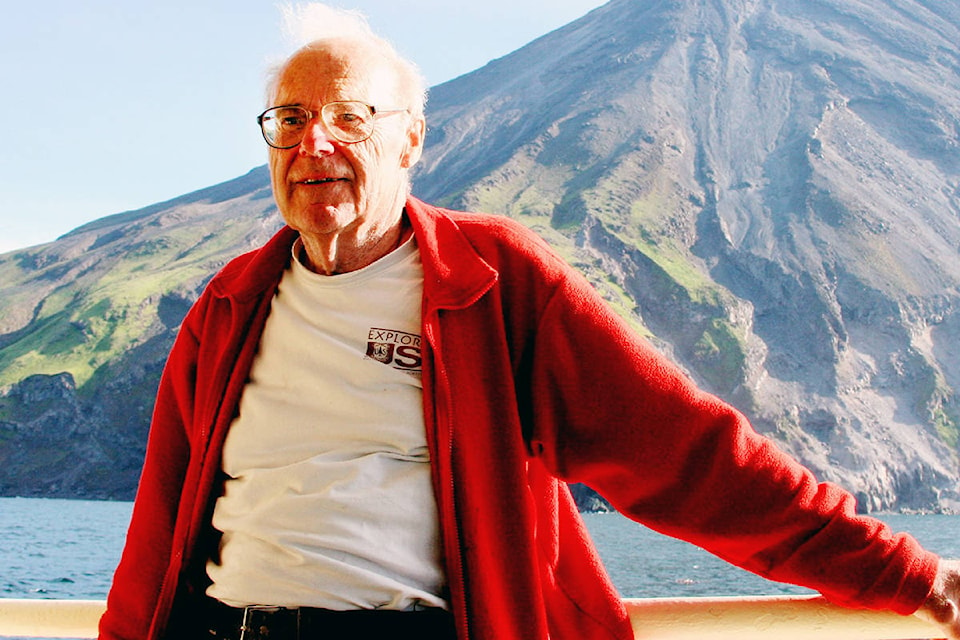The moss is out there. Maybe.
But to find a plant that hasn’t been seen in Canada for four decades, you have to know what you’re looking for.
Wilf Schofield did.
In March 1964, the man who would become B.C.’s pre-eminent bryologist – a scientist who studies bryophytes like mosses, liverworts and hornworts – went hiking on Abbotsford’s Sumas Mountain, looking for a moss that hadn’t been found in Canada since the previous century.
Wilf Schofield was looking for an “extraordinarily tiny” plant called silver hair moss, Fabronia pusilla Raddi, which creeps in flat mats over rock.
It has been found in the western United States, Mexico, Europe and North Africa, but it’s incredibly hard to spot. Its leaves are no longer than a millimetre, its stalks are about three millimetres in length, and, although it has a distinctive “silvery sheen,” it also has the nasty habit of growing alongside larger species.
The moss had been found only once before in Canada. Legendary naturalist John Macoun had found the moss in the late 1800s in the Kootenay River Valley. Macoun’s location records were often incomplete, but it’s believed the site was flooded following the construction of the Keenleyside Dam.
RELATED: How many bears live on Sumas Mountain?
RELATED: How Sumas Mountain’s trails were saved
Schofield scoured Sumas Mountain. Silver hair moss is known to grow on sandstone, and Sumas Mountain has the Lower Mainland’s only deposits of the ancient river rock. Schofield would have focused on semi-shaded cliff faces and crevices that can be found ringing the mountain, but in 1964, the moss was nowhere to be seen.
Schofield was 37 at the time and had been studying mosses for years. In 1960, he had finished his doctoral dissertation and joined the UBC botany department that would become his home for the next three decades. A former student would end up calling him B.C.’s “godfather of mosses.”
Schofield had been told “Don’t go there … all the weird ones move west,” Rene Bellend wrote in an obituary published in 2008.
But while he wasn’t weird, Schofield didn’t heed the warning.
When he came to UBC in 1960, he was the first bryologist at a Canadian university. He would go on to become Canada’s most-distinguished and prominent scholar of mosses. In 1964, though, Schofield had yet to reach the height of Canadian bryology fame. He was just a scientist looking to publish papers on the province’s bryophytes.
On his first visit to Sumas Mountain, he found no silver hair moss. His second trip – in February 1966 – again turned up no Fabronia pusilla Raddi. Ditto for his third trip, in February 1967. A fourth trip later that same spring also turned up no silver.
(Schofield may not have only been focused on silver hair moss. He spent decades roaming B.C., collecting huge amounts of bryophytes during field trips.)
Finally, in March 1968, Schofield returned yet again to the mountain and turned up the moss at two different sites close to one another.
He would have collected a sample to add to the growing collection at UBC. Since Schofield’s arrival, its bryophyte collection had exploded in size. By the end of Schofield’s time at UBC, he would have collected a quarter-million specimens and the university would boast Canada’s second-largest collection of mosses, liverworts and hornworts.
The biggest collection, at the National Museum in Ottawa, was only the size it was, Schofield would say, because he sent them all his duplicates.
The moss’s presence wasn’t just evidence that the species grew as far north as B.C., it was evidence of another millenia, when North America was much warmer.
The progenitors of today’s silver hair moss on Sumas Mountain didn’t travel thousands of kilometres from the southern U.S. The moss can be found on or near Garry oak trees, which once ranged widely from Vancouver to Hope. As the climate gradually cooled over millennia, that historic forest dwindled into isolate pockets of trees, leaving the moss to cling to the side of Sumas Mountain.
But reproducing the success of 1968 would prove challenging.
Schofield returned in 1970, 1973 and 1974, again with no silver-hair payoff.
He knew the general area where he had found the moss in 1968 only by landmarks along his hiking route. There was no GPS yet, Sumas Mountain was large and the moss was so, so tiny.
In March 1976, eight years since his last silver-hair find, Schofield apparently returned again, near the Sumas Mountain escarpment, and again found the rare moss.
It was the last time the rare plant has been seen in Canada, and, again, a precise location isn’t known.
For the next quarter-century, Schofield built a reputation as one of the country’s best botanists – and a warm and generous teacher and mentor. His students would remember his passion for environmental causes and his willingness to share his knowledge and time.
“Wilf was an extraordinary botanist, a fine gentleman, and a good friend and mentor to many lucky people,” Wynne Miles, a former student, would later write.
By the early 2000s, a new generation of bryologists was emerging, and records show that they suddenly started taking a renewed interest in Sumas Mountain and silver hair moss. In November 2001, one of those former students, Terry McIntosh, joined Schofield on a hike to try to find the plant again.
Again, the search proved difficult. Schofield would return to the mountain twice more over the coming decade, but it was McIntosh who would most passionately take up the quest for the moss. He returned to the mountain twice more in 2001 to look for silver hair. He would return in 2003, 2005, 2007, 2008, 2009 and 2010.
The moss’s presence on Sumas Mountain is important to monitor, and not just because it represents the plant’s northernmost point on the continent, McIntosh told The News. Indeed, the silver hair moss is evidence of the significant and historical ecological value of Sumas Mountain.
“Anytime you find a rare species, usually – not always – where it’s found is an area that has been undisturbed for a long, long period of time and the presence of that represents a very old habitat or very old community. So we look at these as things that should be preserved, because there’s probably other things there.”
And as a type of plant, McIntosh warns not to discount seemingly simple mosses.
“They’re quite spectacular, especially at the microscopic level, but even in the forest. Next spring, go wandering out around Sumas Mountain after a rain and when it’s sunny, the forest will glow. A lot of people think mosses are primitive, but they’re … extraordinarily important in ecosystems. They cover things, they prevent erosion, they’re nests for insects and birds. They’re used by a lot of things. They break down, providing nutrients in the forest. They’re just really valuable.”
Schofield died from cancer in 2008, and was hailed as a mountain in the B.C. botany community. A decade later, bryologists and moss-and-lichen enthusiasts meet up once a year for the Wilf Schofield “Bryoforay” to collect specimens.
His legacy lingers in a cohort of bryologists who continue to seek out mosses and other bryophytes.
McIntosh believes silver hair moss likely still exists on Sumas Mountain.
“It’s a big mountain,” he said. “We’ll go again sometime.”
In the meantime, he hopes that others might look at simple pieces of moss with new appreciation, even if it might be near impossible to identify such a tiny moss.
“It’s absolutely great fun. You can sit there have lunch at the base of a cliff seeping, look out over the valley,” he said. “Maybe some kid somewhere along the line says, ‘Let’s go find that.’”

